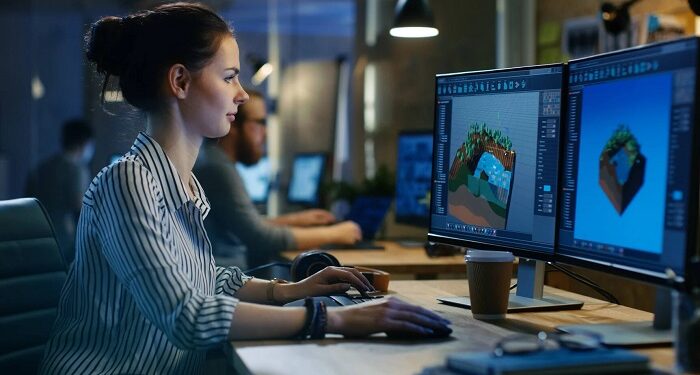Despite the rapid advancement of modern technology, 2D games remain at the peak of popularity. What’s the secret to their success?
In the age of hyper-realistic graphics, immersive VR worlds, and jaw-dropping 3D engines, it might surprise you that 2D animation is not only alive—it’s thriving in the world of game development.
Whether it’s indie hits like Hollow Knight, stylish mobile games, or side-scrollers with nostalgic charm, 2D games are everywhere. But great 2D games don’t just happen. Behind the scenes, there’s often a skilled 2D animation studio helping bring characters, environments, and stories to life.
So, why does 2D animation still matter in game development? Let’s dive into it.
1. Simplicity That Stands Out
One of the biggest strengths of 2D animation in games is its clarity. When done right, 2D visuals are clean, expressive, and easy to understand—especially on smaller screens or crowded interfaces. That’s a huge reason why 2D animation remains dominant in mobile and casual gaming.
Players can instantly recognize a character’s movement, understand what’s happening, and enjoy the aesthetics without needing a high-end PC or console. A good 2D animation studio knows how to use simple visuals to deliver maximum impact.
2. Style Over Realism
Let’s be honest: 3D games often chase realism. And while that’s impressive, it can also start to feel same-y. 2D animation, on the other hand, opens the door to endless stylistic possibilities.
Want a hand-drawn fairy tale vibe? A gritty pixel-art dystopia? A pastel-colored dream world? 2D can do all of it.
Because you’re not bound by physical realism, you can experiment with proportions, exaggeration, or surreal elements. A creative 2D animation studio can help define a game’s identity through visual storytelling that’s anything but generic.
3. Faster Production, Smaller Teams
Compared to full-scale 3D production, 2D animation is often faster and more cost-effective—especially for smaller studios and indie developers. You don’t need to rig complex 3D models, simulate physics, or render everything from multiple angles.
Instead, 2D animation often uses techniques like frame-by-frame animation, bone rigs, or sprite sheets, which are much more manageable.
That’s why many developers turn to a dedicated 2D animation studio. Outsourcing the animation work lets the core team focus on game design, coding, and storytelling while ensuring the visuals meet a high standard.
4. It’s Great for Storytelling
If you want your game to tell a story—especially one with emotional depth—2D animation has some serious advantages. It’s expressive. It’s flexible. And it feels personal in a way that hyper-polished 3D sometimes doesn’t.
Think about classics like Ori and the Blind Forest or Celeste. Their stories hit hard not just because of the gameplay, but because the animation gives heart to every frame.
Facial expressions, body language, environmental cues—all of these are often easier to exaggerate and emphasize in 2D. A good 2D animation studio knows how to support your narrative visually, making moments more impactful without needing a single line of dialogue.
5. It’s Indie-Friendly
Let’s not forget: 2D animation is the backbone of indie gaming. From Stardew Valley to Undertale, countless indie games have become global hits using smart, efficient 2D animation.
Why? Because it lowers the barrier to entry. You don’t need a massive team or multi-million dollar budget to create something beautiful.
But just because it’s “simpler” doesn’t mean it’s easy. Creating polished, professional 2D animation takes skill. That’s where a 2D animation studio can help bridge the gap—especially for indie teams who need to deliver quality on a deadline.
6. Mobile and Web Games Love 2D
Not all games are meant for consoles or Steam. The mobile and browser-based gaming market is enormous, and guess what? 2D animation dominates.
Why? Because 2D assets load faster, perform better on limited hardware, and still look amazing. Whether it’s idle clickers, card games, platformers, or educational games, 2D is the go-to.
Many 2D animation studios specialize in creating assets optimized for performance and screen size. They understand the constraints and how to work within them to create visuals that pop without slowing the game down.
7. It’s Ideal for Prototypes and MVPs
Early-stage game concepts often start with simple visuals. But even at the prototype or MVP stage, first impressions matter.
If your game looks clunky, even if the mechanics are solid, players (or investors) might lose interest. Quick, stylish 2D animation can elevate a rough build into something playable—and even pitchable.
A 2D animation studio can step in early, helping with character design, animation loops, and placeholder assets that still look professional. That way, your game gets taken seriously from day one.
8. Nostalgia Is Powerful
Gamers who grew up on NES, SNES, and Game Boy titles have a soft spot for 2D visuals. And even younger players appreciate the charm of pixel art or side-scrolling action.
Leaning into that nostalgia isn’t lazy—it’s smart. 2D animation taps into a powerful emotional connection with games of the past, while still allowing for fresh ideas and modern mechanics.
Whether you’re reviving retro aesthetics or reimagining them with a modern twist, a 2D animation studio can help find that sweet spot between old-school feel and new-school polish.
9. It Works Across Genres
While 2D is often associated with platformers or puzzle games, it actually fits a wide range of genres:
- Fighting games – like Skullgirls, with its fluid hand-drawn animation.
- Roguelikes – Dead Cells mixes 2D with flashy effects.
- RPGs – From Octopath Traveler to indie turn-based games.
- Visual novels and story-driven games – where character portraits and subtle animation can carry the whole experience.
Whatever your genre, 2D animation can adapt. A solid 2D animation studio will understand how to match the art style and animation pacing to your gameplay mechanics.
10. It’s Easier to Update and Expand
Games don’t stop after launch. New content, seasonal events, or expansions often require fresh visuals. With 2D assets, updates are often easier to manage.
Need a new character skin? A holiday-themed background? An alternate animation for a special move? In 2D, those additions are faster (and cheaper) to produce.
By partnering with a 2D animation studio, you can keep your game visually fresh without reworking your entire pipeline. That kind of flexibility helps games stay relevant longer.
Final Thoughts: Why a 2D Animation Studio Might Be Your Secret Weapon
2D animation isn’t just a throwback. It’s a creative, cost-effective, and highly flexible way to build engaging games that stand out. Whether you’re an indie dev, a mobile-first studio, or even an established publisher, there’s real value in going 2D.
But quality matters. Sloppy animation can ruin immersion and hurt your game’s credibility. That’s why many teams—big and small—choose to collaborate with a 2D animation studio.
Studios bring experience, structure, and professional workflows to the table. They know how to deliver assets that integrate smoothly into your game engine. They understand pacing, weight, movement, and how to match your creative vision with technical reality.
If you’re planning a 2D game—or even just exploring the idea—consider bringing in a studio partner early. It could save you time, stress, and even budget in the long run.
TL;DR
- 2D animation is far from outdated—it’s a powerful tool in modern game development.
- It allows for stylistic freedom, faster production, and better performance across devices.
- A good 2D animation studio can elevate your game’s visuals, storytelling, and overall feel.
- Whether you’re prototyping or scaling post-launch, 2D is flexible, affordable, and still full of magic.
So next time someone says, “Why not just go 3D?”—you’ve got plenty of reasons to smile and stick with 2D.















